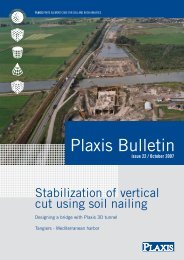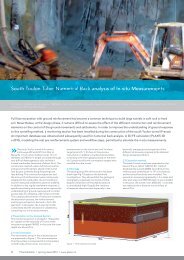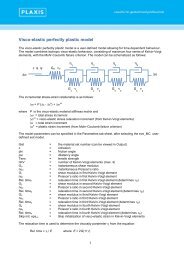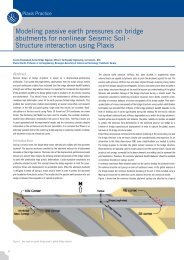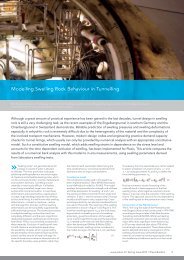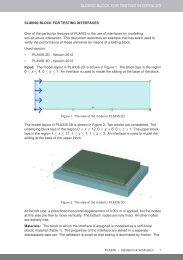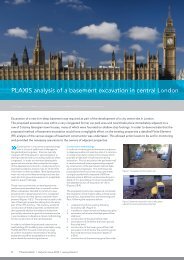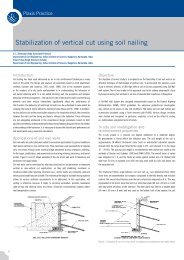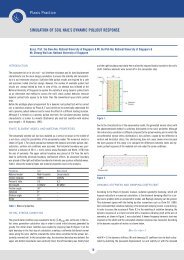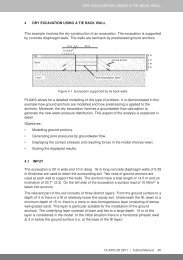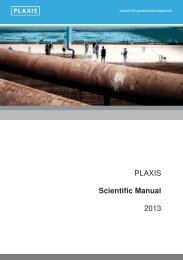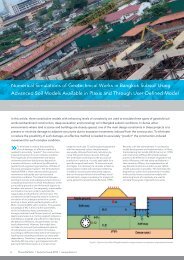Schweiger_ NUMGE_2002.pdf - Plaxis
Schweiger_ NUMGE_2002.pdf - Plaxis
Schweiger_ NUMGE_2002.pdf - Plaxis
Create successful ePaper yourself
Turn your PDF publications into a flip-book with our unique Google optimized e-Paper software.
RESULTS FROM NUMERICAL BENCHMARK EXERCISES IN GEOTECHNICS<br />
H.F. <strong>Schweiger</strong><br />
Institute for Soil Mechanics and Foundation Engineering,<br />
Computational Geotechnics Group, Graz University of Technology, Austria<br />
ABSTRACT. Results of two geotechnical benchmarking exercises are presented. A deep<br />
excavation problem in Berlin sand has been specified by the working AK 1.6 of the German<br />
Society for Geotechnics and a simple tunnel excavation was used by working group A of Cost<br />
Action C7. The results of these exercises clearly emphasize the need for establishing<br />
recommendations and guidelines for numerical analysis in practice.<br />
RÉSUMÉ.<br />
1. Introduction<br />
The significant progress made in the understanding of the behaviour of geomaterials would not<br />
have been possible without the use of numerical methods. In particular, developments in<br />
constitutive modelling are closely related to advances made in the field of numerical analysis and<br />
therefore finite element (and other) methods have had a significant impact on geotechnical<br />
research since the 1970s. Advances in computer hardware and, more importantly, in geotechnical<br />
software over the past ten years have resulted in a widespread application also in practical<br />
geotechnical engineering. These developments enable the geotechnical engineer to perform very<br />
advanced numerical analyses at low cost and with relatively little computational effort.<br />
Commercial codes, fully integrated into the PC-environment, have become so user-friendly that<br />
little training is required for operating the programme. They offer sophisticated types of analysis,<br />
such as fully coupled consolidation analysis with elasto-plastic material models. However, for<br />
performing such complex calculations and obtaining sensible results a strong background in<br />
numerical methods, mechanics and, last but not least, theoretical soil mechanics is essential.<br />
The potential problems arising from the situation that geotechnical engineers, not sufficiently<br />
trained for that purpose, perform complex numerical analyses and may produce unreliable results<br />
have been recognized within the profession and some national and international committees have<br />
begun to address this problem, amongst them the working group AK 1.6 "Numerical Methods in<br />
Geotechnics" of the German Society for Geotechnics (DGGT) and working group A "Numerical<br />
Methods" of the COST Action C7 (Co-Operation in Science and Technology of the European<br />
Union). One of the main goals of AK 1.6 of the DGGT is to provide recommendations for<br />
numerical analyses in geotechnical engineering. In addition benchmark examples are specified<br />
and the results obtained by various users employing different software are compared.<br />
Relatively little attention has been paid in the literature on validation and reliability of numerical<br />
models in general and on specific software in particular, although some attempts have been<br />
made (e.g. <strong>Schweiger</strong> 1998, <strong>Schweiger</strong> 2000). More recently the problem has also been<br />
addressed by Potts and Zdravkovic (2001) and Carter et al. (2000).<br />
In this paper solutions for two benchmark problems, namely a deep excavation in Berlin sand,<br />
specified by the AK 1.6 of the DGGT, and a simple tunnel excavation, specified by the working<br />
group A of the COST Action C7, will be discussed.
2. Undrained analysis of a shield tunnel excavation<br />
2.1. Specification of problem<br />
This example has been specified by the Working Group A of COST Action C7 and has been<br />
deliberately chosen very simple (e.g. constant undrained shear strength instead of increasing with<br />
depth). Undrained conditions are considered and 3 analyses should be performed in terms of total<br />
stresses in plane strain conditions:<br />
Analysis A: elastic, no lining, uniform initial stress state<br />
Analysis B: elastic-perfectly plastic, no lining, K o = 1.0<br />
Analysis C: elastic-perfectly plastic, segmental lining, K o = 1.0, given ground loss<br />
The tunnel diameter is given as 10 m and the overburden (measured from crown to surface) is<br />
assumed to be 15 m. At a depth of 45 m below surface bedrock can be assumed (see Figure 1).<br />
The material parameters for all analysis are given in Table 1.<br />
Table 1. Material parameters for analyses A, B and C<br />
Analysis γ G ν σ v = σ h (K o =1.0) c u E lining ν lining γ lining<br />
kN/m 3 kPa - kPa kPa kPa - kN/m 3<br />
A 20.0 12 000 0.495 - 400 - - - -<br />
B 20.0 12 000 0.495 (z 130 - - -<br />
C 20.0 12 000 0.495 (z 60 2.1 x 10 7 0.18 24.0<br />
Computational step to be performed:<br />
Analyses A and B: full excavation<br />
Analysis C: full excavation with assumed ground loss of 2%<br />
0.0 m surface<br />
A<br />
15 m<br />
z<br />
tunnel diameter = 10 m<br />
B<br />
thickness of lining = 0.3 m<br />
D<br />
C<br />
-45.0 m bedrock<br />
Figure 1. Geometry for benchmark shield tunnel<br />
2.2 Results<br />
Some selected results are presented in the following. 12 solutions (termed ST1 to ST12<br />
respectively) have been submitted. Table 2 summarizes calculated displacements at various
locations which are indicated in Figure 1. It follows that there is a 20% difference of maximum<br />
settlement of point A, which is by no means acceptable for an elastic solution. As will be seen<br />
later this is entirely due to the different assumptions for the lateral boundary condition.<br />
Table 2. Analysis A - calculated displacements of points A, B, C and D [mm]<br />
A B C D vert. D horiz.<br />
ST1 -50 -115 62 -24 -80<br />
ST2 -48 -110 64 -21 -79<br />
ST3 -53 -116 62 -25 -79<br />
ST4 -46 -111 67 -20 -82<br />
ST5 -56 -118 60 -27 -79<br />
ST6 -51 -115 62 -26 -81<br />
ST7 -48 -114 63 -24 -83<br />
ST8 -48 -114 63 -24 -83<br />
ST9 -45 -111 62 -22 -82<br />
ST10 -44 -110 68 -19 -83<br />
ST11 -50 -115 62 -24 -80<br />
ST12 -47 -114 63 -24 -83<br />
Figures 2 and 3 show settlements and horizontal displacements at the surface for the plastic<br />
solution with constant undrained shear strength (Analysis B). In Figure 2 a similar scatter as in<br />
Analysis A is observed with the exception of ST4, ST9 and ST10 which show an even larger<br />
deviation from the "mean" of all analyses submitted. ST5 restrained vertical displacements at the<br />
lateral boundary and thus the settlement is zero here. ST9 used a Von-Mises and not a Tresca<br />
failure criterion which accounts for the difference. The strong influence of employing a Von-Mises<br />
criterion as follows from Figure 2 has been verified by separate studies. It is emphasized<br />
therefore that a careful choice of the failure criterion is essential in a non-linear analysis even for<br />
a simple problem as considered here. The significant variation in predicted horizontal<br />
displacements, mainly governed by the placement of the lateral boundary condition, is evident<br />
from Figure 3. Taking the settlement at the surface above the tunnel axis (point A) the minimum<br />
and maximum value calculated is 76 mm and 159 mm respectively. Thus differences are - as<br />
expected - significantly larger than in the elastic case and again not acceptable.<br />
distance from tunnel axis [m]<br />
0 10 20 30 40 50 60 70 80 90 100<br />
0<br />
-20<br />
vertical displacements [mm]<br />
-40<br />
-60<br />
-80<br />
-100<br />
-120<br />
-140<br />
-160<br />
ST1<br />
ST3<br />
ST4<br />
ST5<br />
ST6<br />
ST7<br />
ST8<br />
ST9<br />
ST10<br />
ST11<br />
ST12<br />
-180<br />
Figure 2. Calculated surface settlements - analysis B
distance from tunnel axis [m]<br />
0 10 20 30 40 50 60 70 80 90 100<br />
0<br />
-5<br />
horizontal displacements [mm]<br />
-10<br />
-15<br />
-20<br />
-25<br />
-30<br />
-35<br />
-40<br />
-45<br />
-50<br />
-55<br />
ST1<br />
ST3<br />
ST4<br />
ST5<br />
ST6<br />
ST7<br />
ST8<br />
ST9<br />
ST10<br />
ST11<br />
ST12<br />
-60<br />
Figure 3. Calculated horizontal displacements at surface - analysis B<br />
Figure 4 plots surface settlements for the elastic-perfectly plastic analysis with a specified volume<br />
loss of 2% and the even wide scatter in results is indeed not very encouraging. The significant<br />
effect of the vertically and horizontally restrained boundary condition used in ST5 is apparent.<br />
However in the other solutions no obvious cause for the differences could be found except that<br />
the lateral boundary has been placed at different distances from the symmetry axes and that the<br />
specified volume loss is modelled in different ways. The range of calculated values for the surface<br />
settlement above the tunnel axis is between 1 and 25 mm and for the crown settlement between<br />
17 and 45 mm respectively. The normal forces in the lining and the contact pressure between soil<br />
and lining do not differ that much (variation is within 15 and 20% respectively), with the exception<br />
of ST9 who calculated significantly lower values.<br />
distance from tunnel axis [m]<br />
0 10 20 30 40 50 60 70 80 90 100<br />
5<br />
0<br />
vertical displacements [mm]<br />
-5<br />
-10<br />
-15<br />
-20<br />
-25<br />
-30<br />
-35<br />
ST1<br />
ST2<br />
ST3<br />
ST4<br />
ST5<br />
ST6<br />
ST8<br />
ST9<br />
ST10<br />
ST11<br />
ST12<br />
-40<br />
Figure 4. Calculated surface settlements - analysis C<br />
After comparing all results submitted, a second round of calculations has been performed. All<br />
authors were asked to redo their analysis with the lateral boundary placed at a distance of 100 m<br />
from the tunnel axis with horizontal displacements restrained. By doing so all solutions for<br />
analyses A and B were within acceptable limits, for analysis C however, still significant<br />
differences in results were obtained, although the range of scatter was reduced (Figure 5). These<br />
differences are most likely due to the way different software handles the specified volume loss.<br />
Again this is a strong case for developing guidelines and reference examples how to model this<br />
(and other) excavation problems.
distance from tunnel axis [m]<br />
0<br />
0 10 20 30 40 50 60 70 80 90 100<br />
vertical displacements [mm]<br />
-5<br />
-10<br />
-15<br />
-20<br />
ST1<br />
ST3<br />
ST5<br />
ST7<br />
ST8<br />
ST9<br />
ST10<br />
-25<br />
Figure 5. Calculated surface settlements - analysis C with lateral boundary at 100 m<br />
3. Deep excavation<br />
3.1. Geometry, basic assumptions and computational steps<br />
The general layout of the problem follows from Figure 6 and the following additional specifications<br />
have been given:<br />
- plane strain<br />
- influence of diaphragm wall construction is neglected, i.e. initial stresses are calculated<br />
without the wall, then wall is "wished-in-place"<br />
- diaphragm wall modelling: beam elements or continuum elements<br />
(E b = 30.0e6 kPa, ν = 0.15, d = 0.8 m)<br />
- interface elements between wall and soil<br />
- horizontal hydraulic cut off at -30.00 m is not considered as structural support, the same<br />
mechanical properties as for the surrounding soil are assumed<br />
- hydrostatic water pressures correspond to water levels inside and outside excavation<br />
(groundwater lowering is performed in one step before excavation starts)<br />
- anchors are modelled as rods, the grouted body as membrane element which guarantee a<br />
continuous load transfer to the soil<br />
- given anchor forces in Figure 1 are design loads<br />
Computational steps to be performed:<br />
stage 0: initial stress state (given by σ' v = γz, σ' h = K o γz, K o = 0.43)<br />
stage 1: activation of diaphragm wall and groundwater lowering to -17.90 m<br />
stage 2: excavation step 1 (to level -4.80 m)<br />
stage 3: activation of anchor 1 at level -4.30 m and prestressing<br />
stage 4: excavation step 2 (to level -9.30 m)<br />
stage 5: activation of anchor 2 at level -8.80 m and prestressing<br />
stage 6: excavation step 3 (to level -14.35 m)<br />
stage 7: activation of anchor 3 at level -13.85 m and prestressing<br />
stage 8: excavation step 4 (to level -16.80 m)<br />
Distance and prestressing loads for anchors follow from Figure 6.
z<br />
x<br />
30 m<br />
excavation step 1 = - 4.80m<br />
excavation step 2 = - 9.30m<br />
2 - 3 x width of excavation<br />
0.00m<br />
GW = -3.00m below surface<br />
27°<br />
27°<br />
19.8m<br />
8.0m<br />
excavation step 3 = -14.35m<br />
excavation step 4 = -16.80m<br />
-17.90m<br />
27°<br />
23.3m<br />
23.8m<br />
8.0m<br />
8.0m<br />
top of hydraulic barrier = -30.00m<br />
-32.00m = base of diaphragm wall<br />
2 - 3 x width of excavation<br />
γ'=γ' sand<br />
Specification for anchors:<br />
prestressed anchor force: 1. row: 768KN<br />
2. row: 945KN<br />
3. row: 980KN<br />
distance of anchors: 1. row: 2.30m<br />
2. row: 1.35m<br />
3. row: 1.35m<br />
cross section area: 15 cm 2<br />
Young's modulus E = 2.1 e8 kN/m 2<br />
sand<br />
0.8m<br />
Figure 6. Geometry and excavation stages<br />
3.2. Material parameters<br />
Some reference values for stiffness and strength parameters from the literature, frequently used<br />
in the design of excavations in Berlin sand, were given (z = depth below surface):<br />
E s ≈ 20 000 √z kPa<br />
E s ≈ 60 000 √z kPa<br />
ϕ = 35°<br />
γ = 19 kN/m 3<br />
γ' = 10 kN/m 3<br />
K o = 1 – sin ϕ<br />
for 0 < z < 20 m<br />
for z > 20 m<br />
(medium dense)<br />
In addition to these values from literature, results from oedometer tests (on loose and dense<br />
samples) and triaxial tests (confining pressures σ 3 = 100, 200 and 300 kPa) have been provided.<br />
It was not possible to include a significantly large number of test results and thus the question<br />
arose whether the stiffness values obtained from the oedometer test have been representative. If,<br />
for example, the constitutive model requires a tangential oedometric stiffness at a reference<br />
pressure of 100 kPa as an input parameter, a value of only Es ≈ 12 000 kPa was found based on<br />
these experiments. If a secant modulus for a pressure range beyond 200 kPa is determined a<br />
value of about 40 000 kPa is obtained. This was considered as too low by many authors and<br />
indeed other test results from Berlin sand in the literature indicate higher values. For example<br />
from Ohde (1951) values of about 35 000 to 45 000 kPa could be estimated as reference loading<br />
modulus of a medium dense sand at a reference pressure of 100 kPa.<br />
Properties for the diaphragm wall (linear elastic):<br />
E = 30 000 x 10 3 kPa<br />
ν = 0.15<br />
γ = 24 kN/m 3
3.3. Comments on solutions submitted<br />
A wide variety of programmes and constitutive models has been employed to solve this problem.<br />
Simple elastic-perfectly plastic material models such as the Mohr-Coulomb or Drucker-Prager<br />
failure criterion (B1, B4, B5, B6, B7, B9, B12 and B16), still widely used in practice have been<br />
chosen by a number of authors. Several entries utilized the computer code PLAXIS (Brinkgreve &<br />
Vermeer 1998) with the so-called Hardening Soil model. One submission used a similar plasticity<br />
model with a simplified small strain stiffness formulation for the elastic range (B14). Three entries<br />
employed a hypoplastic formulation (B3, B3a and B13), B3 without and B3a and B13 with<br />
considering intergranular strains (Niemunis & Herle 1997).<br />
Only marginal differences exist in the assumptions of strength parameters (everybody trusted<br />
the experiments in this respect), the angle of internal friction ϕ was taken as 36° or 37° and a<br />
small cohesion was assumed to increase numerical stability by some authors. A significant<br />
variation was observed however in the assumption of the dilatancy angle ψ, ranging from 0° to<br />
15°.<br />
For reasons mentioned earlier only a limited number of analysts used the provided laboratory<br />
test results to calibrate their material model. Most of the analysts used data from the literature<br />
from Berlin sand or their own experience to arrive at input parameters for their analysis assuming<br />
an increase with depth either by introducing some sort of power law or by defining different layers<br />
with different (constant) Young's moduli. However the choice of the reference moduli for primary<br />
loading and unloading/reloading varied significantly. Additional variation was introduced through<br />
different formulations for interface elements (zero thickness, finite thickness), element types<br />
(linear, quadratic), domains analysed (the width of meshes varied from 80 to 160 m, the depth<br />
from 50 to 160 m), modelling of the prestressed anchors, implementation details of constitutive<br />
models and the solution procedure with respective convergence criteria. The latter aspect is<br />
commonly ignored in practice but it can be easily shown that it may have a significant influence<br />
not only for stress levels near failure but also for working load conditions (Potts and Zdravkovic,<br />
1999).<br />
3.4. Selected results<br />
Because some of the analyses made extremely unrealistic assumptions for the material<br />
parameters (B2, B3, B7, B9 and B17), they have been excluded for the comparison presented in<br />
the following.<br />
Figure 7a depicts lateral displacements of the diaphragm wall due to lowering of the<br />
groundwater level inside the excavation pit to -17.90 m below surface. No clear trend e.g. with<br />
respect to the constitutive model could be identified, B6 is an elastic-perfectly plastic model but so<br />
is B16, both on the opposite sides of the range of results. Observing this variety of results already<br />
in the first construction stage, it is of course not surprising that the scatter increases with further<br />
calculation steps which will be shown later. It should be emphasized at this stage that not only the<br />
assumption of the constitutive model and the parameters have a significant influence on the result<br />
of this construction stage but also the way the groundwater lowering is simulated in the numerical<br />
analysis. Programme specific implementation details, the commercial user of a particular software<br />
may not be aware of, will contribute to the differences shown in Figure 7a. Because of these<br />
possible differences in modelling the groundwater lowering depending on the software used, it<br />
was investigated whether a more clear picture would evolve if a construction stage without the<br />
influence of the groundwater lowering is considered. For that purpose the wall deflection for<br />
excavation step 1 (to -4.80 m below surface) was plotted setting displacements to zero before this<br />
construction stage. The result follows from Figure 7b and the significant scatter already at this<br />
stage is obvious. Although most of the differences can be attributed to the stiffness parameters<br />
chosen as input, a few additional conclusions can be drawn. The largest horizontal displacement<br />
is obtained from the hypoplastic analysis, which was not the case in the previous construction<br />
stage (groundwater lowering). This indicates the strong response of these models on the stress<br />
paths, which are obviously quite different for these two construction steps. This effect of different<br />
stress paths is also observed in the other models but by far not to the same extent. The elasticplastic<br />
models with stress dependent stiffness (B2a, B8, B10 and B14) tend to give smaller
displacements compared to the elastic-perfectly plastic models. Exceptions are B5 and B16,<br />
which show a distinctly different deflection curve although the Young's modulus chosen is similar<br />
to other entries. Most probably is due to the fact that they did not use an interface element for<br />
modelling the soil/wall interaction.<br />
-40 -35 -30 -25 -20 -15 -10 -5 0 5<br />
0<br />
2<br />
4<br />
6<br />
8<br />
10<br />
-60 -55 -50 -45 -40 -35 -30 -25 -20 -15 -10 -5 0 5 10<br />
0<br />
2<br />
4<br />
6<br />
8<br />
10<br />
B1<br />
B2a<br />
B4<br />
B5<br />
B6<br />
B8<br />
B9<br />
B10<br />
B11<br />
B12<br />
B13<br />
B14<br />
B16<br />
12<br />
14<br />
16<br />
18<br />
20<br />
22<br />
24<br />
26<br />
28<br />
30<br />
depth below surface [m]<br />
B1<br />
B2a<br />
B4<br />
B5<br />
B6<br />
B8<br />
B9<br />
B10<br />
B11<br />
B12<br />
B13<br />
B14<br />
B16<br />
12<br />
14<br />
16<br />
18<br />
20<br />
22<br />
24<br />
26<br />
28<br />
30<br />
depth below surface [m]<br />
32<br />
-40 -35 -30 -25 -20 -15 -10 -5 0 5<br />
horizontal displacement [mm]<br />
32<br />
-60 -55 -50 -45 -40 -35 -30 -25 -20 -15 -10 -5 0 5 10<br />
horizontal displacement [mm]<br />
Figure 7. Wall deflection a) after groundwater lowering, b) for first excavation step<br />
Limited in situ measurements are available for this project and although some simplifications<br />
compared to the actual construction have been introduced for this benchmark exercise in order to<br />
facilitate the calculations, the order of magnitude of displacements can be assumed to be known.<br />
Figure 8 shows the measured wall deflection for the final construction stage together with<br />
calculated values. It should be mentioned that measurements have been taken by inclinometer<br />
readings, fixed at the base of the wall, but unfortunately no geodetic survey of the wall head is<br />
available. It is very likely that the wall base moves horizontally and a parallel shift of the<br />
measurement is thought to reflect the in situ behaviour more closely, and therefore the<br />
measurement readings have been shifted by 10 mm in Figure 8. This is confirmed by other<br />
measurements under similar conditions. The calculated maximum horizontal wall displacement<br />
for all results considered varies between approximately 10 to 65 mm (exception B6). The shape<br />
of the deflection curves is also quite different. Some results indicate the maximum displacement<br />
slightly above the final excavation level, others show the maximum value at the top of the wall.
measurement<br />
(corrected)<br />
-80 -70 -60 -50 -40 -30 -20 -10 0 10<br />
0<br />
2<br />
4<br />
6<br />
8<br />
10<br />
B1<br />
B2a<br />
B4<br />
B5<br />
B6<br />
B8<br />
B9<br />
B10<br />
B11<br />
B12<br />
B13<br />
B14<br />
B15<br />
B16<br />
measurement<br />
(corrected)<br />
12<br />
14<br />
16<br />
18<br />
20<br />
22<br />
24<br />
26<br />
28<br />
30<br />
depth below surface [m]<br />
32<br />
-80 -70 -60 -50 -40 -30 -20 -10 0 10<br />
horizontal displacement [mm]<br />
Figure 8. Calculated wall deflections after final excavation step<br />
distance from wall [m]<br />
20<br />
0 10 20 30 40 50 60 70 80 90 100<br />
vertical displacement of surface [mm]<br />
10<br />
0<br />
-10<br />
-20<br />
-30<br />
-40<br />
-50<br />
B1<br />
B2a<br />
B4<br />
B5<br />
B6<br />
B8<br />
B9<br />
B10<br />
B11<br />
B12<br />
B13<br />
B14<br />
B15<br />
B16<br />
Figure 9. Calculated surface settlements after final excavation step
When comparing the results of the calculations with the measurements it has to be pointed out<br />
that the simplification introduced in modelling the groundwater lowering (one step lowering<br />
instead of step-wise lowering according to the excavation progress) leads to higher horizontal<br />
displacements. Further studies revealed that the difference in calculated horizontal displacements<br />
due to the difference in modelling the groundwater lowering is strongly dependent on the<br />
constitutive law employed and ranges in the order of 5 to 15 mm. This may be one of the reasons<br />
why B15, which is an elastic-plastic analysis with stepwise groundwater lowering, is close to the<br />
measurement, but it also means that all solutions predicting less than 30 mm of horizontal<br />
displacement are far off reality.<br />
Figure 9 depicts the calculated surface settlements. Settlements of 45 mm (B11) have to be<br />
compared with a heave of about 15 mm (B4). Considering the fact that calculation of surface<br />
settlements is one of the main goals of such an analysis these results are not very encouraging.<br />
4. Conclusion<br />
Results from a geotechnical benchmark exercise have been presented. A typical problem of a<br />
deep excavation in Berlin sand, formulated by the working group 1.6 of the German Society for<br />
Geotechnics, has been solved by a number of geotechnical engineers from universities and<br />
consulting companies utilizing different finite element codes and constitutive models. The<br />
comparison of the solutions submitted showed a wide scatter in results and only the most<br />
extreme solutions on the far end of the range could be explained with respect to assumptions of<br />
input parameters made in the analysis. Some of the results showed obvious errors such as<br />
incorrect prestress forces of anchors but most analyses made reasonable assumptions for<br />
parameters, discretisation and other modelling details.<br />
This benchmark exercise demonstrates the strong need for guidelines and recommendations<br />
how to model typical geotechnical problems in practice. Pitfalls and unrealistic modelling<br />
assumptions, the commercial user may not be aware of, have to be pointed out and procedures<br />
have to be developed to identify these.<br />
5. References<br />
Brinkgreve R.B.J., Vermeer P.A. (1998), PLAXIS: Finite element code for soil and rock analyses, version 7.<br />
Balkema.<br />
Carter, J.P, Desai, C.S., Potts, D.M., <strong>Schweiger</strong>, H.F. & S.W. Sloan 2000. Computing and Computer<br />
Modelling in Geotechnical Engineering. Proc. GeoEng2000, Melbourne, Technomic Publishing,<br />
Lancaster. (Vol. 1: invited papers), 1157-1252.<br />
Niemunis, A. & I. Herle 1997. Hypoplastic model for cohesionless soils with elastic strain range. Mechanics<br />
of cohesive-frictional materials, 2, 279-299.<br />
Ohde, J. 1951. Grundbaumechanik (in German), Huette, BD. III, 27. Auflage.<br />
Potts, D.M & L. Zdravkovic (1999). Finite element analysis in geotechnical engineering – Theory. Thomas<br />
Telford<br />
Potts, D.M & L. Zdravkovic (2001). Finite element analysis in geotechnical engineering – Application.<br />
Thomas Telford<br />
<strong>Schweiger</strong>, H. F. 1998. Results from two geotechnical benchmark problems. Proc. 4th European Conf.<br />
Numerical Methods in Geotechnical Engineering, Cividini, A. (ed.), Springer, 645-654.<br />
<strong>Schweiger</strong>, H. F. 2000. Ergebnisse des Berechnungsbeispieles Nr. 3 "3-fach verankerte Baugrube".<br />
Tagungsband Workshop "Verformungsprognose für tiefe Baugruben", Stuttgart, 7-67. (in German)<br />
REFERENCE:<br />
Results from numerical benchmark exercises in geotechnics<br />
Proc. 5th European Conf. Numerical Methods in Geotechnical Engineering, Presses Ponts et<br />
chaussees, Paris, 2002, 305-314



